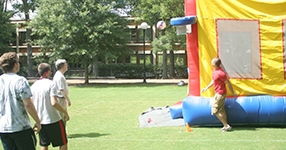A nearly ubiquitous sight on the suburban landscape, inflatable bounce houses mark the fun and frivolity at children’s parties and other events practically year round. But a new study from Andrew Grundstein and Marshall Shepherd in geography examines the heat safety issues that can put children in danger amid all the innocent play:
Expanding on the concept of microclimates like those in parked vehicles that cause serious injuries to children, the study investigated potential heat-related risks associated with bounce houses, which create a microclimate environment similar to automobiles but one that had not been previously examined.
The new paper, "Do Inflatable Bounce Houses Pose Heat-related Hazards to Children," was published July 28 in the early online edition of the Bulletin of the American Meteorological Society.
The study examined specific research questions that compared temperature and moisture conditions inside the bounce house to ambient outdoor conditions, and whether such differences might reach levels that pose health risks.
This work is receiving wide attention in the media and rightly so. Our researchers are very concerned about the effects of extreme heat on vulnerable populations and especially children. This work is a further example of that concern taking the form of a scientifically-generated advisory that should help people make more informed decisions almost immediately. News you can use.
Image: photo from the July 2015 bounce house demo on which the new study is based.

